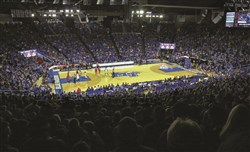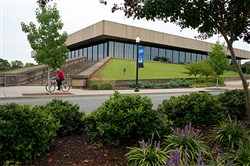VOL. 46 | NO. 36 | Friday, September 9, 2022
Murphy’s law
By Joe Morris
From future NBA and country stars to traveling circuses and science fairs, MTSU’s Charles M. Murphy Athletic Center has hosted them all. And as plans gear up for its 50th anniversary this fall, renovations and upgrades show how it remains relevant as a sports destination and host to other events even as newer, larger sites have lured away its concert business.
Losing concerts to bigger arenas isn’t of much concern to campus officials, who always point out that “athletic” is in the center’s name. It wasn’t built to be a concert hall, they say, but to showcase Blue Raiders basketball and other sports, mostly men’s in those early Title IX days.
In that, it very much succeeded. From Dec. 11, 1972, when the men’s team hosted Vanderbilt in Murphy Center’s first game, what became known as the “Glass House” is still a hot ticket for college sports.
Still, Murphy’s Midstate location and size – the Monte Hale/Jimmy Earle Arena main hall portion seats 11,520 – made it appealing for a lot of touring musicians in the 1970s and 1980s, and school officials were loath to pass up the chance to make some money.

The heavyweights of the music industry have surrendered the court to sports, for the most part, including MTSU athletics and the TSSAA boys and girls state championship basketball tournaments.
-- Photo By Mtsu AthleticsThat meant acts from Elvis to Elton John, U2 to Tina Turner. Willie Nelson, Bruce Springsteen, Kanye West and The Who played the venue in their prime. It also hosted the 1979 NCAA Basketball Tournament’s Mideast Regional that featured Tennessee, Notre Dame and Magic Johnson’s Michigan State University squad en route to a national championship, says Jim Simpson, who worked at Murphy as athletic ticket manager in the early days and now is director emeritus of the MTSU Varsity Club.
“I think the basketball tournaments over the years have showcased the building to its absolute highest level,” Simpson says. “A lot of planning goes into those events so they’ll turn out perfectly. Thinking back on those early ones, I believe the University of Tennessee was in some, and seeing this new building got them going on discussions about building a new arena in Knoxville (Stokely Athletic Center had been built in 1958 and was demolished in 2014; Thompson-Boling Arena opened in 1987.)
The center was built as a working campus building as much as an events venue, Simpson adds, so calendaring ahead and meticulous planning was essential.
“The health, physical education and recreation departments shared the building with the athletics department, and in those days there were a lot of PE classes, so it was pretty much a half-half split,” Simpson recalls.
“Harold Smith, our director of student programming, formed committees that handled different areas of student programming, one of which was the concert committee. That was a popular one, because they ran the shows – which mostly meant taking the tickets, although sometimes they got to work on the show if it wasn’t a union tour. It was a great experience for them.”
Murfreesboro getting new music venue
Murphy Center may have a friend soon. The Murfreesboro City Council voted in August to approve a development agreement with Notes Live Inc. for a new entertainment campus. The 4,500-seat, open-air Sunset Music Colosseum on the Stones River will be in the Murfreesboro Gateway development near I-24.
Closer to home, a fundraising campaign, Build Blue, has been launched to fund a student-athlete performance center, multipurpose indoor practice facility and fund improvements to Murphy Center, which include a new entrance with escalators, more fan amenities and further improvements. Information
Over the years, the building also has housed class registration, all campus commencements and many for area high schools as well, alongside science fairs, career fairs, antique shows and conventions.
It also hosted a 1975 retirement dinner on the main floor for Murfreesboro’s Robert James, a three-time Pro Bowl defensive back. That night’s featured speaker was James’ roommate with the Buffalo Bills, O.J. Simpson.
Most, but not all, of these events went off as planned. As the science fair competitors would know, there’s no getting around the laws of physics.
“I do remember that Elton John’s piano fell off the stage when they were loading it out after his show, so we had to repair the basketball floor,” Simpson says. “And back in 1973, one of our first events was the Hanneford Circus, an actual circus that played college arenas.

Murphy Center also has hosted high school and university graduations for 50 years.
-- Photo By Michelle Morrow |The Ledger“They had an elephant, and they had a terrible time getting it in and out. If you’ve seen our doorways into the bottom level, they’re pretty big – but not elephant-sized.”
The pachyderm made it inside for what would be its final bow in the spotlight. The elephant died a few days later en route to the circus’ next gig at East Tennessee State University, Simpson recalls.
Rise of other venues
Murphy remained the place for high-profile shows until 1996 when the Nashville Arena (now Bridgestone Arena) opened. The multipurpose venue was larger, newer and in downtown Nashville, and quickly began to snap up traveling performing acts. That was fine with MTSU, Simpson says.
“The arena had a much higher gross potential than Murphy, so of course performers wanted to go there. I think in 1995 we had George Strait, and Chris Young, and that pretty much did it. There are some other performances here still, but not the major acts that we’d been getting up to that time.”
That made for fewer scheduling headaches at Murphy, given that it hosted a full slate of athletic events, as well as physical education and other classes, and a show meant three days of no activity on the arena floor during setup, performance and teardown. The venue staff had been making it work for years, Simpson says, but not without a lot of effort.
The competition
Murphy Center has seen several Midstate concert venues rise during its 50 years, most new and some old. And one no longer with us.
Here’s a look:
Allen Arena at Lipscomb University
Opened: 2001
Capacity: 5,584
Ascend Amphitheater
Opened: 2015
Capacity: 2,300 fixed seats, 4,500 lawn seats
Bridgestone Arena
Opened: 1996
Capacity: 17,159 (hockey), 19,395 (basketball), 10,000 (half-house concerts), 18,500 (end-stage concerts), 20,000 (center-stage concerts), 5,145 (Music City Theater configuration), 43,000 square feet (trade show space)
Aka: Nashville Arena, Gaylord Entertainment Center, Sommet Center
Curb Event Center at Belmont University
Opened: 2003
Capacity: 5,085
FirstBank Amphitheater
Opened: 2021 in Thompson’s Station
Capacity: 7,500
Grand Ole Opry House
Opened: 1974
Capacity: 4,400
Municipal Auditorium
Opened: 1962
Capacity: 9,654 (concert and event seating), up to 32,928 square feet of arena floor space, 38,400-square-foot plaza
Nissan Stadium
Opened: 1999
Capacity: 69,143
Aka: Adelphia Coliseum, The Coliseum, LP Field
Ryman Auditorium
Opened: 1892
Capacity: 2,362
Aka: Union Gospel Tabernacle, Grand Ole Opry House
Starwood Amphitheatre
Opened: 1986
Demolished: 2007
Capacity: 17,137
Aka: First American Music Center, AmSouth Amphitheatre
Tennessee Performing Arts Center (TPAC)
Opened: 1980
Capacity: 2,472 (Andrew Jackson Hall), 1,075 (Polk Theater), 256 (Andrew Johnson Theater)
War Memorial Auditorium
Opened: 1925
Capacity: 1,661 seats
“It wasn’t like Murphy was sitting vacant waiting for a concert,” he says. “Those traveling tours had very set schedules, and if we had a basketball tournament or something else going on, then we couldn’t host about as often as we could.”
The Nashville Arena, on the other hand, was built for purpose and soon had a full roster of events, including Nashville Predator home games, says David Kells, executive vice president of entertainment and venues.
“The production for concerts alone has changed so much in the 25 years we’ve been open, not to mention going back 50 years,” Kells says. “The venues need different infrastructure, things like more dressing rooms, more rigging capacity, a stronger power structure.
“We’ve done a good job on consistently investing in the venue for those needs, as well as behind-the-scenes improvements like more efficient HVAC systems, chiller plants for the hockey ice and upgraded lighting fixtures. There’s also been plenty of changes to things that visitors do see, such as new seats, bathroom and concession upgrades and enhanced security.”
“It’s a lot to keep up with, but it’s necessary if you want your arena and venue to be viable for a long time,” Kells says, adding that the arena averages 14 to 16 events a month, then hosts the entire Predators season and massive events such as the CMA Awards.
Like Murphy, its visibility also helps grow the local economy. It was named the No. 1 arena in the world for concert ticket sales in 2021 by Pollstar and continues to grow its footprint by hosting a wider variety of events, including more Latin and R&B acts, which Kells says will continue to grow its audience for other activities and drive downtown visitation and spending.
Another half century?
Even as Murphy Center has stepped away from hosting large-scale traveling shows, attention is always paid to its role as a sports venue. That means upgrades, overhauls and enhancements as needed, and sometimes even if not quite needed but very much wanted. Seats, for example.
“That was something of a color issue,” Simpson says, adding that “We had 18 sections, each with sets of three seats in green, orange, blue, yellow, white and red. It was a psychedelic place to be, but I suppose in the early 1970s that was pretty popular. They’re all blue now, which is a lot prettier, plus they are much nicer seats.”
The original arena floor was replaced in 2000, although the running track around the upper level remains original. Locker rooms have been refurbished, and most recently the building’s namesake glass was replaced. The building originally had 520 7-foot square panes, a number that is now doubled with SageGlass panels that can be controlled individually to tint as much as needed, when needed. That solves the problem of afternoon sunlight streaming in from behind the west basketball goal.
“They look very different, and have changed the overall look of the building,” Simpson says. “I think it looks a lot better, and now we can do a lot of neat things with the tinting.”
As it celebrates the half-century mark, Murphy Center also will be honored as a gathering place that brought attention to MTSU and Murfreesboro, he adds.
“It has been a catalyst for growth at the university, and for the city and Rutherford County,” he says. “I think that sometimes gets overlooked.
“When we opened the building and began having all these major concerts and tournaments, Murfreesboro and MTSU began getting a lot of visitors. That included high school kids and their parents, who might not have visited the school when they were looking at college options, for instance. And the building’s success certainly influenced the building of other arenas throughout the area.”